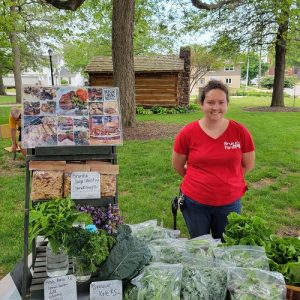CLICK HERE for the latest market quotes from the Iowa Agribusiness Network!
CLICK HERE for the latest market quotes from the Brownfield Ag News Network!
CLICK HERE for the latest market quotes from the Iowa Agribusiness Network!
CLICK HERE for the latest market quotes from the Brownfield Ag News Network!
(Radio Iowa) – The rain farmers have been hoping for slowed some of the harvest last week. The U-S-D-A reports says rainfall cut the time in the field by about two days. The corn harvest is now nine percent statewide, compared to five percent the week before. The corn harvest is still six days ahead of last year.
The percentage of beans in the bin hit 11 percent last week — up from three percent. The bean harvest is three days ahead of last year, and one day ahead of the five-year average.
(Radio Iowa) – It’s still early, but the harvest season in northwest Iowa is getting off to a good start, according to I-S-U Extension agronomist Leah Ten Napel. “Overall, we have a lot of acres left to go,” Ten Napel says. “A very small percentage has been harvested so far. The areas that are getting harvested are actually at fairly good, harvestable moistures, which is great to hear, and yields are not coming back all too shabby for the year we’ve had.”
Weather conditions during this growing season were widely varied, she says, and so are the yields. “Some of our soybean fields were hit really hard with late-season pests and those yields are going to be down in those areas,” she says, “but overall, corn yields have been average-to-above-average and soybean yields maybe slightly below-average-to-average, so far, what I’m hearing.”
Ten Napel says some farmers are predicting about a 200-bushel average for the corn crop. “I would say for our area of northwest Iowa, we may be over that 200 bushel average, in my area,” she says, “just from what I’m hearing so far.” Ten Napel says much of her region received adequate moisture this season, though she notes, parts of Woodbury and Monona counties, just south of Sioux City, were among the driest in the state.
(Clive, Iowa) September 25, 2023 – The Iowa Pork Producers Association is partnering with four Iowa State University football players to promote the pork industry. Through an NIL (name, image, likeness) deal, Cyclones Myles Purchase, Tyler Moore, Tommy Hamann, and Caleb Bacon are leading the new “Purchase Moore Hamann Bacon” marketing campaign. The goal is obviously to push Iowans to buy pork products. More specifically, they want you to purchase more ham and bacon.
“After the ‘Hamann Bacon’ photo went viral on social media following the Cyclones’ season opener, we knew we had to jump on this opportunity,” said Trish Cook, president of the Iowa Pork Producers Association. “These four young men are not only great football players, they also have strong academic records, and great last names! We couldn’t be more excited to work with them in this fun initiative to publicize Iowa pork.”
“These four young men are not only great football players, they also have strong academic records, and great last names! We couldn’t be more excited to work with them in this fun initiative to publicize Iowa pork.”
October is National Pork Month, aka Porktober, and this promotion will be part of that monthlong celebration. The Iowa Pork Producers Association will run ads on social media featuring the four players surrounded by delicious Iowa pork and strategically using their names to encourage pork consumption. In conjunction with the NIL partnership, the Iowa Pork Producers Association will donate $1,000 of pork to each player’s food pantry of choice. “Iowa pork producers and pig farmers care about their communities, and while this partnership is a fun way to promote our industry, it’s also one way we can give back,” Cook said. “Food insecurity remains an issue for many people and we’re glad to partner with these Cyclone football players to help their local food pantries.”
Myles Purchase, Tyler Moore, and Caleb Bacon were all named to the Academic All-Big 12 First Team in 2022. Tommy Hamann was named to the Big 12 Commissioner’s Honor Roll in 2022. The Iowa Pork Producers Association is pleased to work with these student-athletes to promote pork and the work of Iowa pig farmers, while aiding local communities. “It’s something unique and it feels good to be able to do something for a good cause,” said Cyclones Defensive Back Myles Purchase, a junior from Denver, CO. “It’s a really crazy way to incorporate all of our names and I think it’s a great way to promote Iowa pork producers too,” said Cyclone Tight End Tyler Moore, a redshirt sophomore from Des Moines.
When the picture of Tommy Hamann and Caleb Bacon together on the field went viral on social media, the players had several friends sharing the photo with them. “I think it’s just hilarious being able to use play-on words on our last names in a super clever way to promote Iowa pork and it’s just an all-around great opportunity to bring us all together,” said Hamann, a redshirt freshman defensive end for the Iowa State Cyclones. Caleb Bacon has heard jokes about his last name for much of his life. “People said I should take advantage of it, and it just came to fruition in that picture. I think it’s just good for our teammates and I’d like to thank the Iowa pork producers for the opportunity.” Bacon is a sophomore linebacker from Lake Mills, Iowa.
Iowa is the number one state in the nation for pork production and nearly 150,000 Iowans are employed by the pork industry.
(Atlantic, Iowa) – Produce in the Park is a weekly farmers market and community gathering held every Thursday evening from 4:30 PM – 6:30 PM in the Atlantic City Park, through October 12th. This week (Sept. 28th), local musician Sarah Selders will be providing live music and Hungry Spartan Pizza food truck will be on site from 4:30 PM – 6:30 PM. Numerous vendors will be in attendance offering a variety of products including baked goods, produce, sweet treats and crafts.
You can also look forward to the following specialty items with numerous other vendors and community organizations in attendance:
Aubrey’s Bows: assortment of bows including new fall bow collections
Bridgewater Farms: wide assortment of produce including sweet potatoes
Brun Ko Farms: honey, radishes, peppers, sweet snacking peppers, 5, 10 & 20 lb boxes of heirloom slicing tomatoes, onions, garlic & jalapenos and leeks
CK3 Farms: wide assortment of produce including watermelon
Harrisdale Farmstead: assortment of produce including grapes
Imagine Garden Gifts: unique garden gifts including antique, vintage, and repurposed planters.
Kringleman: assorted Danish pastries
Neighborhood Bakehouse: sourdough, baguettes, sandwich bread & pumpkin spice sourdough
Noble Provisions: homegrown ribeyes, beef snacks (jerky, summer sausage, beef sticks), beef brats, patties, pork brats, Italian sausage, & ground pork
Thursday’s featured kids activity will be bounce houses and yard games. Zion Recovery, our September sponsor, will have numerous agencies at the park as well as activities for kids to enjoy.
All vendors accept cash, with many accepting credit cards and Venmo. All qualifying food vendors accept SNAP/EBT (also known as food stamps) with all fresh produce vendors accepting Double Up Food Bucks–coupons given for SNAP/EBT purchases of fresh produce.
For updates and information on Produce in the Park or how to sign up to participate, visit www.produceintheparkatlanticiowa.com. ‘Like’ or ‘follow’ Produce in the Park on Facebook (www.facebook.com/ProduceInThePark) or Instagram (www.instagram.com/produceintheparkatlanticia/).
Produce in the Park is sponsored by: First Whitney Bank & Trust, Cass Health, Nishna Valley Family YMCA, Gregg Young of Atlantic, Atlantic Area Chamber of Commerce and the City of Atlantic.
(Radio Iowa) – A grain that millions of people in Asia and India eat every day is almost unheard-of in Iowa, but a researcher at Iowa State University says it has the potential to make Midwestern agriculture more resilient, more profitable and more earth-friendly. Pat Schnable, director of I-S-U’s Plant Sciences Institute, says proso (PRO-so) millet is an ideal alternative crop to corn and soybeans, especially as water becomes more scarce, both in drought-stricken Iowa and globally. “Proso millet is extremely water efficient,” Schnable says. “We did some research and discovered that it is probably the most water efficient grain on the planet. It uses about half as much water per bushel of grain compared to corn or wheat. It’s even more water efficient than sorghum.”
Calling proso millet the crop of the future, Schnable says the cereal grain is extremely versatile as it’s eaten by vast populations of humans in products from porridge to bread, and it’s also an excellent livestock feed. Plus, he says, millet is already growing well in plots of Iowa soil, thanks to one big advantage. “Farmers can grow millet without any application of nitrogen fertilizer,” he says. “So even though the yields are 70 to 80 bushels an acre, here in Iowa, by not having to add nitrogen fertilizer, that can make it competitive with corn and beans.” By comparison, corn is now grown on some 90-million acres nationwide, while millet is grown on perhaps 700-thousand acres. Schnable would like to see that figure grow tenfold in the years to come.
“It’s a very easy crop to grow in Iowa and uses exactly the same equipment that you’ve got for corn and beans, so same planters, same combine,” he says. “You do need to get a canola plate for the planter but that’s a pretty trivial expense, just because it’s smaller seeded than corn and beans.” The grain is gluten-free, so it’s being used domestically in various types of 12-grain breads — and it’s even used in those big mixed bags of bird seed. Yet another advantage, Schnable says proso millet can be substituted for corn in the ethanol-making process.
“Because we’re not adding commercial fertilizer, nitrogen fertilizer, it has a low carbon intensity score, which starting in 2025, the federal government is going to start handing out credits to ethanol plants that use low carbon intensity feedstocks, like millet,” Schnable says, “so we see a real growth opportunity there.” Schnable and his son, James — who’s an agronomy professor at the University of Nebraska-Lincoln — founded an Ames-based company called Dryland Genetics. Its mission is to make proso millet the climate conscious choice of farmers and consumers.
Today: Sunny with a high near 77. West wind 5 to 10 mph.
Tonight: Mostly clear with a low around 54.
Monday: Mostly sunny with a high near 77. West northwest wind 5 to 10 mph.
Tuesday: A slight chance of showers and thunderstorms in the afternoon. Mostly sunny with a high near 75.
Wednesday: Mostly sunny with a high near 75.
Saturday’s High in Atlantic was 76. Our Low was 55. Rainfall at KJAN from 7-a.m. Saturday to 7-a.m. Sunday amounted to .25″.
Enrollment is open for youngsters to join 4-H for the 2023-24 program year. Cass County Iowa State University Extension 4-H Youth Coordinator Katie Bateman says 4-H is all about learning.
Cass County enrollment is free due to the money raised through different events, like the annual Fall Fest on October 8th from 2:00 pm to 4:00 pm at the fairgrounds. Bateman says youngsters can choose a specific club.
She says enrollment is easy.
Cass County 4-H will host a new member information night on December 4th at 5:30 pm at the Cass County Community Building.
Today: Showers and thunderstorms likely. High near 77. Breezy with a southeast wind 5 to 10 mph increasing to 10 to 15 mph5. Winds could gust as high as 25 mph. 5
Tonight: A chance of showers and thunderstorms. Partly cloudy, with a low around 56. South southwest wind 5 to 10 mph.
Sunday: Sunny with a high near 76. West wind 5 to 10 mph.
Monday: Sunny with a high near 77.
Tuesday: Sunny with a high near 79.
Friday: Showers and thunderstorms likely, mainly this morning. Cloudy with a high near 74. East southeast wind 5 to 10 mph.
Friday Night: A chance of showers and thunderstorms, mainly after midnight. Mostly cloudy with a low around 64. Southeast wind 5 to 10 mph.
Saturday: Showers and thunderstorms, mainly after 10am. High near 78. Windy, with a south southeast wind 15 to 20 mph, with gusts as high as 30 mph.
Sunday: A chance of showers and thunderstorms. Mostly sunny, with a high near 76.
Monday: A slight chance of showers and thunderstorms in the afternoon. Mostly sunny, with a high near 75.
As farmers in many parts of Iowa launch into the harvest, Iowa Secretary of Agriculture Mike Naig says there’s good news for producers who might need to dry their grains using heaters fueled by tanks of liquid propane. While L-P supplies have been tight in recent years, Naig says that doesn’t appear to be the case this season, as fall arrives on Saturday.
Propane prices are averaging around a dollar-77 a gallon in Iowa, which is down from around two-16 a year ago.
Naig remains optimistic prices will hold steady as we head into the cold weather months.
It’s also a plus for Iowans who heat their homes with L-P. Estimates show about 67% of Iowans use natural gas to heat their homes, 15% use electricity, and 14% use liquid propane.